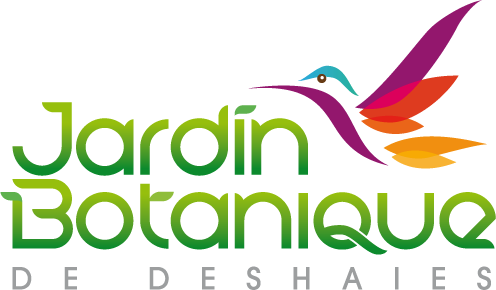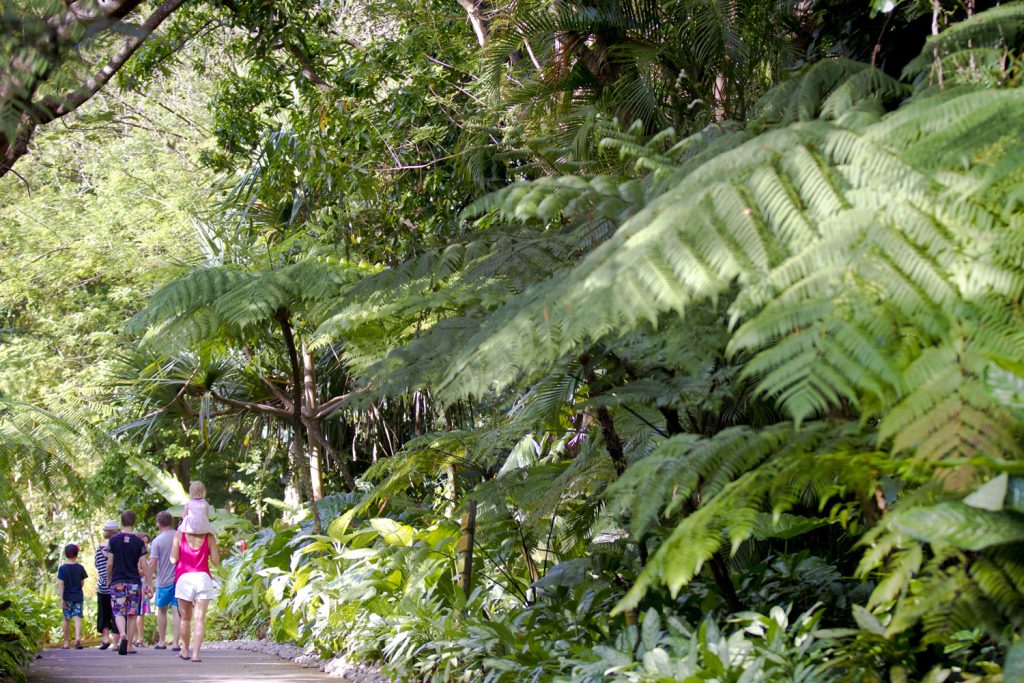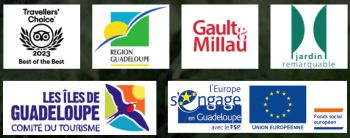 Jardin et collections
Jardin et collections
Le jardin se situe entre 60 et 130 m d’altitude.
La zone se caractérise par une formation végétale semi-décidue. Cependant, l’espace a été modifié et planté d’espèces indigènes et exogènes.
Le jardin est situé au lieu-dit Villers. Il est situé sur une colline relativement escarpée, en arrière littoral sur une superficie d’environ 5.5 Ha.
La structure forestière n’a pas été conservée.
Néanmoins, on y trouve des espèces indigènes remarquables : courbaril Hymenaea courbaril, Fromager Ceiba pentandra, Gommier rouge Bursera simaruba — Bois d’inde Pimenta racemosa, Poirier pays – Tabeuia heterophylla , Manguier – Mangifera indica, etc..
Un parcours de visite d’environ 1h30 à 2 heures qui présente successivement les diverses collections
Pour respecter la tradition des jardins botaniques, ce parc se devait d’accorder une large place aux collections végétales.
Plusieurs zones du jardin sont ainsi consacrées à la présentation de familles ou d’espèces de plantes : nénuphars, orchidées, hibiscus, bougainvilliers, bananiers, succulentes, palmiers… Un maximum de variétés y sont regroupées, pour mettre en valeur leur diversité et leurs qualités ornementales.
Ces collections ne se limitent pas aux zones qui leur sont dévolues et se dispersent dans l’ensemble du jardin. Certaines collections, comme celles des Héliconias, ne se découvrent même qu’au fil de la promenade.
En même temps, une identité se dégage des différentes parties du jardin, de véritables univers différents les uns des autres.
 Les différents thèmes du parc
Les différents thèmes du parc
Situé à l’entrée du parc, un étang artificiel de plus de 50m de long et sa magnifique collection de nénuphars, de papyrus et de plantes aquatiques, parmi lesquels évoluent des Carpes Koï.
Passé le sas de sécurité, une trentaine de Loriquets, petits perroquets d’Australie aux couleurs vives accueillent les visiteurs, et n’hésitent pas à venir se poser sur leur tête le temps d’une photo.
Dans un passage mi-ombre, mi-soleil, des orchidées en fleurs grimpent et s’entremêlent sur les arbres. Différentes espèces offrent un spectacle gracieux et riche en couleurs. Les passionnés de ces fleurs connaissent leur fragilité et apprécieront la beauté des variétés présentées.
Une allée colorée s’ouvre aux visiteurs offrant une remarquable palette de couleurs . La collection des variétés présentées ne laissera personne indifférent.
Un espace large et aéré dominant la mer des Caraïbes, une multitude d’arbres composent le paysage : Palmiers Royaux, Bombax, Baobab, Jacaranda, l’Arbre à pain, Avocats, Calliandra et Araucaria.
Aux abords du restaurant panoramique, cet arbre impressionnant par sa forme et ses centaines de racines aériennes formant son tronc, était l’un des endroits préférés de Coluche.
De 10 mètres de haut, la cascade mélange, de roches naturelles et artificielles surplombées par le restaurant, enchante les visiteurs qui traversent le bassin par un petit pont de bois. La tradition veut que l’on jette une pièce dans l’eau dans l’espoir de voir réaliser ses vœux.
A quelques mètres de la cascade, un enclos est réservé à 14 flamants rouges de la Caraïbe. Ce sont les pionniers d’une réintroduction de l’espèce sur l’île. En effet, avant les années 40, les flamants rouges habitaient la région de Saint François.
Une forêt de bambous se dresse dans le paysage, isolant les visiteurs du reste du parc. Hauts de plusieurs mètres, ils offrent un endroit de charme et de fraîcheur. Diverses espèces sont représentées comme les Bambusa Vulgaris, les Multip lex, les Aztèques.
Un torrent de 60 mètres accompagne les visiteurs tout au long du parcours apportant une ambiance de sérénité, amplifiée par le bruit de l’eau, qui s’écoule à 150 m3/heure.
Un mur d’eau végétalisé de 25 mètres de long surprend au détour d’un chemin et laisse émerger des plantes aquatiques telles que les jacinthes d’eau aux fleurs bleues, et de nombreuses plantes épiphytes (Broméliacées, Orchidées et papyrus).
Dans ce « village » composé de 6 petites maisons aux couleurs locales, les habitants ne sont autres que des perroquets ARAS. Ces oiseaux au plumage flamboyant présentés en enclos ouvert, représentent le symbole de la forêt tropicale et équatoriale.
Une allée plantée de différentes variétés de palmiers présente un aspect idyllique du paysage traditionnel des îles. Le Double Palmier Royal impressionne par son originalité. Le passage sous une tonnelle où des plantes grimpantes évoluent, est rafraîchissant grâce à un système de brumisation.
Ce palmier très rare est originaire du Sri-Lanka. D’une durée de vie entre 80 et 100 ans, il meurt après avoir donné son unique fleur. Le premier spécimen planté dans le parc a offert pendant quelques dizaines d’années sa magnificence incontestable, avant de fleurir et de mourir. Sa progéniture l’a rejoint en terre pour assurer la relève.
De la végétation luxuriante des îles, le parcours nous conduit dans une zone désertique et aride. Des dizaines d’espèces de cactées aux épines plus ou moins longues se dressent dans un décor mexicain, où cohabitent Pachypodium (palmier de Madagascar) et Nolina beaucarnéa (pied d’éléphant).
Cependant le clou du spectacle est la collection de « Melocactus intortus « (Tête à l’anglais) qui est incrit sur la liste rouge mondiale des espèces menacées.
Les concepteurs du jardin botanique ne pouvaient pas oublier de présenter au public l’incroyable beauté des fougères arborescentes. Ces fougères ne s’épanouissant qu’à partir de 500m d’altitude, le parc étant situé à seulement 110m, il a fallu reconstituer le climat humide et frais de la montagne, en installant un système d’irrigation, par brumisation, programmé par ordinateur. Aux pieds de ces fougères ont été plantées de nombreuses broméliacées et plantes épiphytes, comme le philodendron giganteum.
Sur le plan technologique, l’irrigation est une véritable innovation dans le jardin. Afin de palier la chaleur excessive et de maintenir l’humidité optimum dont a besoin la végétation tropicale, un système aérien de brumisation est programmé par ordinateur. Ce procédé américain fonctionne depuis la fin des années 80 dans le sud de la France et a connu une notoriété mondiale lors de l’exposition universelle de Séville en 1992.



